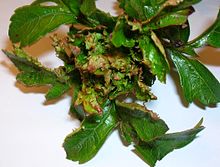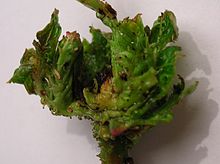- Dasineura crataegi
-
'Dasineura crataegi' Button-top gall on Hawthorn Scientific classification Kingdom: Animalia Phylum: Arthropoda Class: Insecta Order: Diptera Family: Cecidomyiidae Genus: Dasineura Species: D. crataegi Binomial name Dasineura crataegi
(Winnertz, 1853)The hawthorn button-top gall, is caused by the dipteron gall-midge Dasineura crataegi (Winnertz, 1853). The gall develops in the terminal shoots of Hawthorn, Crataegus monogyna (Jacq.) and the midland hawthorn Crataegus laevigata (Poir.) and their hybrids.[1][2]
Synonyms are Perrisia crataegi and Cecidomyia crataegi, (Winnertz, 1853).[3]
Contents
The physical appearance of the galls
The gall causer induces stunted and distorted rosettes[4] in the host by inhibiting the elongation of the shoot; the rosette is formed from many (8 to 40 or more) slightly thickened and deformed leaves with reduced petioles. Many of the leaves have small green or red ligulate excrescences or projections. The midge larvae are of a orange-red colour.[1][2]
The gall is occasionally found on isolated shrubs, however hedges are more commonly infested with the new growth resulting from hedge cutting of being the site of high density populations. The rosettes stand out prominently against the sky. Old galls persist and new elongations of the branch occurs from unaffected buds lying well behind the terminal bud.[3]
Life-cycle
Adults emerge from pupae in the ground beneath the shrub and the terminal bud infestations start in March or April; the fully grown larvae fall to the ground in September or October to undergo pupation after feeding and sheltering within the leaf rosette for some time.[3]
Distribution and control
The nettle pouch gall shows a scattered distribution throughout England, however it is an under recorded species.[5] The gall can be controlled by spraying with insecticide at the larval stage.[6]
Parasitoids
Aprostocetus lysippe is a hymenopteran insects of the family Eulophidae and a parasitoid of D. crataegi.
See also
References
- Notes
- Sources
- Darlington, Arnold (1968). The Pocket Encyclopaedia of Plant Galls in colour. Pub. Blandford Press. Dorset. ISBN 0-7137-0748-8
- Hancy, Rex (2000). The Study of Plant Galls in Norfolk. The Norfolk and Norwich Naturalist's Society.
- Redfern, Margaret & Shirley, Peter (2002). British Plant Galls. Identification of galls on plants & fungi. AIDGAP. Shrewsbury : Field Studies Council. ISBN 1-85153-214-5.
- Stubbs, F. B. Edit. (1986) Provisional Keys to British Plant Galls. Pub. Brit Plant Gall Soc. ISBN 0-9511582-0-1.
External links
Categories:- Cecidomyiidae
- Galls
Wikimedia Foundation. 2010.



